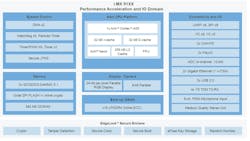One of the primary features of Linux is its flexibility. Its extensibility and ease of programming have helped turn it into one of the most widely used operating systems in embedded systems that need to be updated and upgraded over time.
Now, NXP Semiconductors is trying to bring it into the era of edge computing with its new i.MX 91 family. Based on Arm’s Cortex-A55 CPU, the processors are said to strike a balance between high performance, connectivity, and security as well as power efficiency and cost, suiting them for the next generation of Linux-based consumer, industrial, and medical devices.
Charles Dachs, SVP and GM of Industrial and IoT Edge at NXP, said the i.MX 91 is “setting a new standard for Linux platforms across IoT and industrial applications,” and it can serve as “the foundation for thousands of new device classes.”
Dachs added that “the i.MX 91 family enables the rapid development of platforms that may easily pivot into new markets and new applications, leveraging existing investments and streamlining product line updates,” as it has hardware and software compatibility with the rest of NXP’s i.MX 9 offerings.
Packed with Performance
The i.MX 91 app processor family is based on a single Arm Cortex-A55 CPU core clocked at up to 1.4 GHz and 16 lanes of LPDDR4 for the purposes of memory expansion, giving it a leap in performance over the previous-generation iMX 93. Based on the same 16-nm FinFET process as the rest of the i.MX 9 platform, the chips are housed in 11- × 11-mm or 9- × 9-mm packages with 0.5-mm pitch.
The chips come with a rich set of connectivity features that fit the flexibility of Linux, including Gigabit Ethernet with time-sensitive networking (TSN) and USB Type-C. NXP said the I.MX 91 family is also equipped with a wide range of I/O features for everything from the factory floor to the smart home, including eight UARTs, eight I2C, eight SPI, and dual I3C interfaces, with a 12-bit ADC (see figure).
The new entry point for the i.MX 9 series, i.MX 91 plugs into NXP’s industrial platform for smart factories and can be paired with its N-AFE chips, which run sensors and actuators. i.MX 91 is also relevant in smart homes when attached to the company’s tri-radio IW612 that supports Wi-Fi 6, Bluetooth 5.2, and 802.15.4. It also works with Matter, the emerging connectivity standard for the smart home.
One of the company’s EdgeLock secure enclaves is embedded in the i.MX 91. This gives it access to advanced security features, including device lifecycle management and secure boot, among others.
Jim McGregor, principal analyst at Tirias Research, said the i.MX 91 family will give companies the ability to “add intelligence into traditional embedded and IoT systems, while also delivering scalability through the larger i.MX 9 series.” NXP explained that i.MX 91 shares common package and software libraries with the i.MX 9 series, allowing customers to easily upgrade from the i.MX 93.
On the other end of the i.MX 9 family is the i.MX 95—a secure, high-performance embedded processor that integrates NXP’s in-house neural processing unit (NPU) for on-device machine learning and a 3D GPU.
Supported by the company’s ecosystem of tools plus software and support, the i.MX91 series is guaranteed for a minimum of 15 years of availability as part of NXP’s product longevity program.
Early-access development kits will be available in the second half of 2023.
